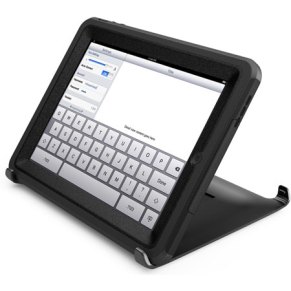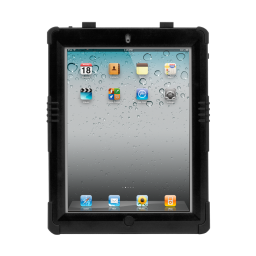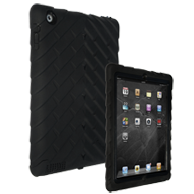4 Ways iPads Are Changing the Lives of People With Disabilities
http://mashable.com/2011/07/25/ipads-disabilities/Noah Rahman has moderate Cerebral Palsy affecting his communication, cognition and upper and lower body movement. When he turned two, his language, cognitive abilitity and fine motor skills were diagnosed by a developmental specialist as being at least 12 months behind. Then Noah got an iPad.
Four months later, his language and cognition were on par with his age level. His fine motor skills had made significant leaps.
Today, the three-year-old (pictured at right with his father) spends an hour or two on his iPad each day. He switches his apps between reading and writing in English, Arabic and Spanish. In the fall, he’ll enter a classroom of five-year-olds. “The iPad unlocked his motivation and his desire because it’s fun,” says his dad Sami Rahman, co-founder of SNApps4Kids, a community of parents, therapists and educators sharing their experiences using the iPad, iPod touch, iPhone and Android to help children with special needs.
SNApps4Kids taps into a burgeoning trend for people with disabilities. Touch devices — most notably the iPad — are revolutionizing the lives of children, adults and seniors with special needs. Rahman estimates some 40,000 apps have been developed for this demographic.
“Touch has made it exceptionally accessible — everyone has an iPad, everyone has an iPod,” says Michelle Diament, cofounder of Disability Scoop, a source for news relating to developmental disabilities. “If you’re someone with a disability, having something that other people are using makes you feel like part of the in-crowd.”
For people lacking motor skills, touch screens are more intuitive devices. There is no mouse, keyboard or pen intercepting their communication with the screen. Larger platforms, like iPads, are preferred over smaller iOS and Android devices for ease-of-use and, of course, the cool factor.
Here are four ways that touch devices are changing the lives of people with disabilities:
Before the iPad and other similar devices, using touch-to-speak technology was incredibly expensive, costing around $8,000. Now, it only costs $499 for an iPad and $189.99 for a thorough touch-to-speak app like Proloquo2Go.
That relative affordability has made the technology more available for children and adults that can’t use their voice. With the simple touch of an iPad, a hungry non-verbal person can communicate exactly what he or she would like to eat. Those apps can then be customized with photos or features to suit an individual’s life and needs.
Another option is Assistive Chat, which predicts several sentence completion options. For the most severely disabled people, Yes|No is a simple app that allows individuals to voice their preference in yes-or-no responses.
“It gives dignity back to people who are more disabled,” says Vicki Windham, a special education teacher in the Clarkstown Central School District who trains people of all ages to make the most of their iPads. Windham reviews apps for people with a variety of special needs.
For hard-of-hearing iPad users, soundAmp R amplifies sound in a variety of situations. Users can also record lectures or presentations they want to listen to again later.
SNApps4Kids co-founder Cristen Reat’s son Vincent was born with Down syndrome, which can also lead to low-muscle mass. While he can walk, Reat describes his son as a Buddha that prefers to sit still most of the time. Throughout his life, Vincent’s therapists and parents have tried to help him be more active. It was not until his physical therapist placed an iPad on a treadmill that Vincent was motivated to walk. He now stays on for nine and a half minutes, interacting with his iPad while he’s in motion.
In addition to increasing his gross motor ability to walk, Vincent’s iPad has helped his fine motor skills. For Vincent, computers and older technology required visual shifting — between a mouse or keyboard and the screen. On an iPad, Vincent can watch as one of his fingers writes directly on the screen to make selections.
Similarly, Noah Rahman has shown motor improvement. After playing the Elmo Loves ABCs app on his iPad, he can write the entire alphabet, requiring sophisticated finger isolation. As a three-year-old, this puts him well above his grade level. “First it was ‘do it for me,’ then it was ‘do it with me,’ now he does it by himself,” says Noah’s father.
Years ago, one of Jeremy Brown’s autistic elementary school students picked up his iPhone off his desk and began navigating the iOS with ease. “It’s like a fish to water,” says Brown, a teacher for autistic elementary school students, of his students’ interactions with touch technology.
Brown is immersed in online discussions of technology and special education, moderating the Facebook group iTeach Special Education, collaborating on the podcast EdCeptional and coauthoring the blog Teaching All Students. While use of the iPad in classrooms is not yet approved in his school district, he believes the iPad is a great supplemental method of instruction, estimating 80% to 90% of his students with autism see great results when using iOS devices. Brown hopes his school district and others across the country will approve iPads in the classroom.
While no one advocates replacing traditional instruction, a number of apps do address academic subjects from math to language to reading and writing. In October 2010, Apple even featured an “Apps for Special Education” section in the App Store.
Brown encourages parents to separate their children’s recreational uses of the iPad from those in the classroom. Some students may watch YouTube videos on the school bus but while they’re at school they know Mr. Brown’s iPads are only for education.
Behavior Tracker Pro is a popular app for parents, therapists and teachers to quantify the behavioral progress of children with special needs. In addition to taking notes, good and bad behaviors can be video recorded and later reviewed. The app automatically turns that input into visual graphs and charts.
High school teacher Vicki Windman notes that the iPad can also be a great way to strengthen and reinforce memory for seniors with Alzheimer’s or memory loss. Still, she warns that touch technology is not a miracle drug: “You’re not curing Alzheimer’s. Parents challenge me all the time — they want a cure. It’s no cure.”
That doesn’t mean it can’t help. Apps like Medication Reminder tell users when it’s time to take medication. Memory Practice, a memory strengthening app, was created for the developer’s mother shortly after she was diagnosed with Alzheimer’s. Windman’s father uses an app called Nudge, which gives him a persistent reminder every fifteen minutes to accomplish lapsed tasks on his to-do list.
Despite these successes, SNApps4Kids cofounder Cristen Reat recommends a measured approach. “Just because you buy a device doesn’t mean it’s going to change anything,” she says.
Rahman agrees. He says that viewing the iPad as the solution is the backwards approach. “We are big advocates that the user needs to understand the objectives first before you pick the technology,” Rahman says. “We’re not just putting [our son] in front of an iPad and walking away. That’s the real key.”
Image courtesy of Sami Rahman.
Four months later, his language and cognition were on par with his age level. His fine motor skills had made significant leaps.
Today, the three-year-old (pictured at right with his father) spends an hour or two on his iPad each day. He switches his apps between reading and writing in English, Arabic and Spanish. In the fall, he’ll enter a classroom of five-year-olds. “The iPad unlocked his motivation and his desire because it’s fun,” says his dad Sami Rahman, co-founder of SNApps4Kids, a community of parents, therapists and educators sharing their experiences using the iPad, iPod touch, iPhone and Android to help children with special needs.
SNApps4Kids taps into a burgeoning trend for people with disabilities. Touch devices — most notably the iPad — are revolutionizing the lives of children, adults and seniors with special needs. Rahman estimates some 40,000 apps have been developed for this demographic.
“Touch has made it exceptionally accessible — everyone has an iPad, everyone has an iPod,” says Michelle Diament, cofounder of Disability Scoop, a source for news relating to developmental disabilities. “If you’re someone with a disability, having something that other people are using makes you feel like part of the in-crowd.”
For people lacking motor skills, touch screens are more intuitive devices. There is no mouse, keyboard or pen intercepting their communication with the screen. Larger platforms, like iPads, are preferred over smaller iOS and Android devices for ease-of-use and, of course, the cool factor.
Here are four ways that touch devices are changing the lives of people with disabilities:
1. As a Communicator
Before the iPad and other similar devices, using touch-to-speak technology was incredibly expensive, costing around $8,000. Now, it only costs $499 for an iPad and $189.99 for a thorough touch-to-speak app like Proloquo2Go.
That relative affordability has made the technology more available for children and adults that can’t use their voice. With the simple touch of an iPad, a hungry non-verbal person can communicate exactly what he or she would like to eat. Those apps can then be customized with photos or features to suit an individual’s life and needs.
Another option is Assistive Chat, which predicts several sentence completion options. For the most severely disabled people, Yes|No is a simple app that allows individuals to voice their preference in yes-or-no responses.
“It gives dignity back to people who are more disabled,” says Vicki Windham, a special education teacher in the Clarkstown Central School District who trains people of all ages to make the most of their iPads. Windham reviews apps for people with a variety of special needs.
For hard-of-hearing iPad users, soundAmp R amplifies sound in a variety of situations. Users can also record lectures or presentations they want to listen to again later.
2. As a Therapeutic Device
SNApps4Kids co-founder Cristen Reat’s son Vincent was born with Down syndrome, which can also lead to low-muscle mass. While he can walk, Reat describes his son as a Buddha that prefers to sit still most of the time. Throughout his life, Vincent’s therapists and parents have tried to help him be more active. It was not until his physical therapist placed an iPad on a treadmill that Vincent was motivated to walk. He now stays on for nine and a half minutes, interacting with his iPad while he’s in motion.
In addition to increasing his gross motor ability to walk, Vincent’s iPad has helped his fine motor skills. For Vincent, computers and older technology required visual shifting — between a mouse or keyboard and the screen. On an iPad, Vincent can watch as one of his fingers writes directly on the screen to make selections.
Similarly, Noah Rahman has shown motor improvement. After playing the Elmo Loves ABCs app on his iPad, he can write the entire alphabet, requiring sophisticated finger isolation. As a three-year-old, this puts him well above his grade level. “First it was ‘do it for me,’ then it was ‘do it with me,’ now he does it by himself,” says Noah’s father.
3. As an Educational Tool
Years ago, one of Jeremy Brown’s autistic elementary school students picked up his iPhone off his desk and began navigating the iOS with ease. “It’s like a fish to water,” says Brown, a teacher for autistic elementary school students, of his students’ interactions with touch technology.
Brown is immersed in online discussions of technology and special education, moderating the Facebook group iTeach Special Education, collaborating on the podcast EdCeptional and coauthoring the blog Teaching All Students. While use of the iPad in classrooms is not yet approved in his school district, he believes the iPad is a great supplemental method of instruction, estimating 80% to 90% of his students with autism see great results when using iOS devices. Brown hopes his school district and others across the country will approve iPads in the classroom.
While no one advocates replacing traditional instruction, a number of apps do address academic subjects from math to language to reading and writing. In October 2010, Apple even featured an “Apps for Special Education” section in the App Store.
Brown encourages parents to separate their children’s recreational uses of the iPad from those in the classroom. Some students may watch YouTube videos on the school bus but while they’re at school they know Mr. Brown’s iPads are only for education.
4. As a Behavior Monitor
Behavior Tracker Pro is a popular app for parents, therapists and teachers to quantify the behavioral progress of children with special needs. In addition to taking notes, good and bad behaviors can be video recorded and later reviewed. The app automatically turns that input into visual graphs and charts.
High school teacher Vicki Windman notes that the iPad can also be a great way to strengthen and reinforce memory for seniors with Alzheimer’s or memory loss. Still, she warns that touch technology is not a miracle drug: “You’re not curing Alzheimer’s. Parents challenge me all the time — they want a cure. It’s no cure.”
That doesn’t mean it can’t help. Apps like Medication Reminder tell users when it’s time to take medication. Memory Practice, a memory strengthening app, was created for the developer’s mother shortly after she was diagnosed with Alzheimer’s. Windman’s father uses an app called Nudge, which gives him a persistent reminder every fifteen minutes to accomplish lapsed tasks on his to-do list.
Long-Roads Ahead
Despite these successes, SNApps4Kids cofounder Cristen Reat recommends a measured approach. “Just because you buy a device doesn’t mean it’s going to change anything,” she says.
Rahman agrees. He says that viewing the iPad as the solution is the backwards approach. “We are big advocates that the user needs to understand the objectives first before you pick the technology,” Rahman says. “We’re not just putting [our son] in front of an iPad and walking away. That’s the real key.”
Image courtesy of Sami Rahman.








